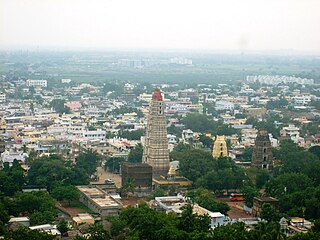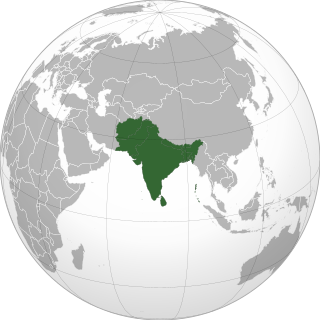
Mangalagiri is a model town in Guntur district situated between the twin cities of Vijayawada and Guntur of the Indian state of Andhra Pradesh. It is a major sub-urb region of Vijayawada. It is currently the 9th most populous city of Andhra Pradesh. The town is the headquarters of Mangalagiri mandal under Guntur revenue division. It is a major suburb of the cities of Vijayawada and Guntur. It is situated on National Highway 16 between Vijayawada and Guntur. The town was known to have existed since 225 B.C..

East Godavari is a district in the Coastal Andhra region of Andhra Pradesh, India. Its district headquarters is at Kakinada. As of Census 2011, it became the most populous district of the state with a population of 5,151,549. Rajahmundry and Kakinada are the major cities in the district in terms of population.

The history of southern India covers a span of over four thousand years during which the region saw the rise and fall of a number of dynasties and empires. The period of known history of the region begins with the Iron Age period until the 15th century CE. Dynasties of Chera, Chola, Pandyan, Chalukya, Pallava, Satavahana Rashtrakuta, Kakatiya, Reddy dynasty, Seuna (Yadava) dynasty and Hoysala were at their peak during various periods of history. These Dynasties constantly fought amongst each other and against external forces when northern armies invaded southern India. Vijayanagara empire rose in response to the Muslim intervention and covered the most of southern India and acted as a bulwark against Mughal expansion into the south. When the European powers arrived during the 16th and 18th century CE, the southern kingdoms, most notably Tipu Sultan's Kingdom of Mysore, resisted the new threats, and many parts eventually succumbed to British occupation. The British created the Madras Presidency which acted as an administrative centre for the rest of South India, with them being princely states. After Indian independence South India was linguistically divided into the states of Tamil Nadu, Andhra Pradesh, Karnataka, Telangana and Kerala.

Krishnadevaraya was the emperor of the Vijayanagara Empire during 1509–1529. He was the third ruler of the Tuluva Dynasty and is considered to be its greatest ruler. He possessed the largest empire in India after the decline of the Delhi Sultanate. Presiding over the empire at its zenith, he is regarded as an icon by many Indians. Krishnadevaraya earned the titles Kannada Rajya Rama Ramana, Andhra Bhoja and Mooru Rayara Ganda. He became the dominant ruler of the peninsula of India by defeating the Sultans of Bijapur, Golconda, the Bahmani Sultanate and the Gajapatis of Odisha, and was one of the most powerful Hindu rulers in India. Indeed, when the Mughal Emperor Babur was taking stock of the potentates of north India, Krishnadevaraya was rated the most powerful and had the most extensive empire in the subcontinent.
Sultan Quli Qutb Shah, a Turkmen from Hamadan in Iran, was the founder of the Qutb Shahi dynasty, which ruled the Sultanate of Golconda in southern India from 1518 to 1687. He died in 1543.

Achyuta Deva Raya was a ruler of a Vijayanagara Empire of South India. He was the younger brother of Krishna Deva Raya, whom he succeeded in 1529.

The Reddi kingdom or Kondavidu Reddi kingdom was established in southern India by Prolaya Vema Reddi. The region that was ruled by the Reddi dynasty is now part of modern-day coastal and central Andhra Pradesh. Prolaya Vema Reddi was part of the confederation that started a movement against the invading Turkic armies of the Delhi Sultanate in 1323 and succeeded in repulsing them from Warangal.
The Sangama dynasty was a dynasty of the Vijayanagara Empire founded in the 14th century by two brothers: Harihara I and Bukka Raya I.

Nellore district, officially Sri Potti Sriramulu Nellore district, is one of the thirteen districts in the Indian state of Andhra Pradesh. According to the 2011 Census, the district's population was 2,966,082, of which 29.07% was urban. Its administrative headquarters are located in Nellore city. Located in the Coastal Andhra region, the district is bordered by the Bay of Bengal to the east, Kadapa district to the west, Prakasam district to the north, and Chittoor district and Thiruvallur district of Tamil Nadu to the south.
Historians have deciphered writings on the walls of temples describing the names and gotras of some Telugu rulers and the contributions made by them to the temples and towns.
Saluva Narasimha Deva Raya was an emperor of the Vijayanagara Empire from the Saluva Dynasty. A patron of the Madhwa saint Sripadaraya, he authored the Sanskrit work Rama Bhyudayam. He also patronised Kannada poet Kavi Linga.

Venkatagiri is a town in Nellore district of the Indian state of Andhra Pradesh. It is a municipality and mandals headquarters of Venkatagiri mandal. Venkatagiri's old name is "Kali Mili". It is famous for its Handloom Cotton Sarees. Venkatagiri is a place for history and handlooms. It was part of a small kingdom that was integrated into the Indian Republic.
Pemmasani Nayaks were a ruling clan in the south Indian state of Andhra Pradesh. They came into prominence during Vijayanagara times as rulers of Gandikota around 300 years. After the Battle of Talikota in 1565 AD, the collapse of Vijayanagara Empire led to the emergence of Pemmasani Nayakas in the Rayalaseema region who protected Hindu dharma for more than 100 years up to 1685 AD. Pemmasani Kings helped Aravidu dynasty Kings in battles with Muslim kings to protect Hindu religion in South India. They belonged to the Kamma social group.

Andhra Pradesh is a state in India. Andhra Pradesh Tourism Development Corporation (APTDC) is a state government agency which promotes tourism in Andhra Pradesh, describing the state as the Koh-i-Noor of India. Andhra Pradesh has a variety of tourist attractions including beaches, hills, caves, wildlife, forests and temples.

Kapilendra Deva was the founder of the Gajapati dynasty that ruled parts of eastern and southern India, including present-day Odisha as the center of his empire. He had staged a military coup against the preceding and the last Eastern Ganga dynasty ruler Bhanu Deva IV and overtook the throne as the king was weak and had lost territories to the south. His name is also written as Kapilendra Routray or Sri Sri Kapilendra Deva. In claiming descent from the Surya Vamsha of the Mahabharata, he also took the title shri shri ...(108 times) Gajapati Gaudeshwara NabaKoti Karnata Kalabargeswara. This title literally meant the lord of Bengal (Gauda), of Karnataka region or Vijayanagara kingdom, of Golkonda kingdom and of nine crore subjects. The title is still used by the sun dynasty kings of Puri on ritual occasions.

The Military of Vijayanagara supported the Vijayanagara Empire in particular with regard to the empire's long-lasting rivalry with the Bahmani Sultanate. Besides a large standing army, the Vijayanagara rulers also maintained a powerful navy. This helped make the Viayanagara empire the most centralised polity ever to have emerged in South India. However, a major portion of the imperial income was committed to military purposes, straining the economy.
Udayagiri Assembly constituency is a constituency of the Andhra Pradesh Legislative Assembly, India. It is one of 10 constituencies in the Nellore district.

Bira Pratapa Purushottama Deva was an Gajapati emperor of Odisha who ruled from 1467 to 1497 C.E. He was the second ruler from the Gajapati dynasty. His father Gajapati Kapilendra Deva Routaraya chose him as his heir to rule Odishan Empire at the banks of river Krishna where he breathed his last. This decision infuriated the elder brother Hamvira Deva who was a battle hardened and successful warrior fulfilling the task of conquering the southern territories and expeditions against the kingdom of Vijayanagara as wished by his father.

Prataparudra Deva was the last Gajapati emperor of Odisha from the Suryavamshi dynasty started by his grandfather Kapilendra Deva Routaraya. He ruled from the year 1497 to 1540 A.D. Besides being a ruler, he was a devout Vaishnava and adherent of the famous saint, Sri Chaitanaya who arrived in Odisha during is rule. His life was extremely occupied with overwhelming military campaigns in defense of his inherited territory from three frontal invasions by the enemy states Vijayanagar, Hussain Shahi dynasty of Bengal and Qutb Shahi dynasty of Golconda. He lost large portions of his territory to the neighboring enemy states initiating the dissolution of Odisha's military hegemony and imperial status that continued for nearly a period of 600 years before him.

Siddhavatam is a village in Kadapa district of the Indian state of Andhra Pradesh. It is located in Siddavatam mandal of Rajampeta revenue division.















